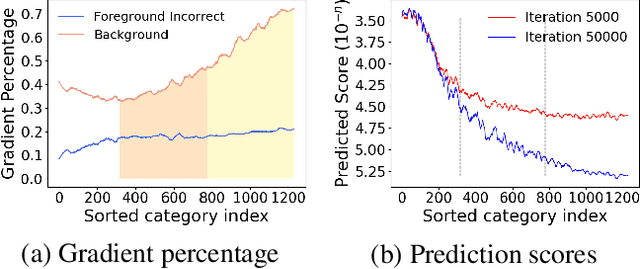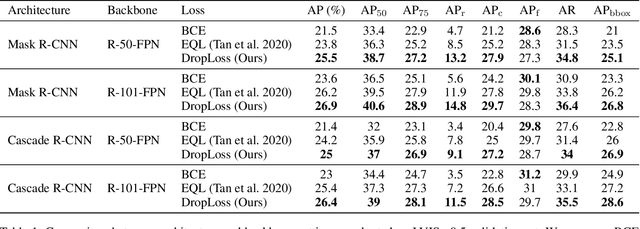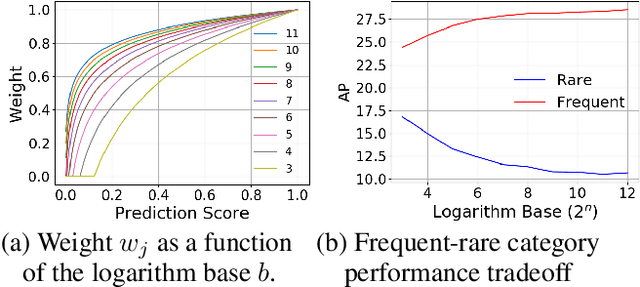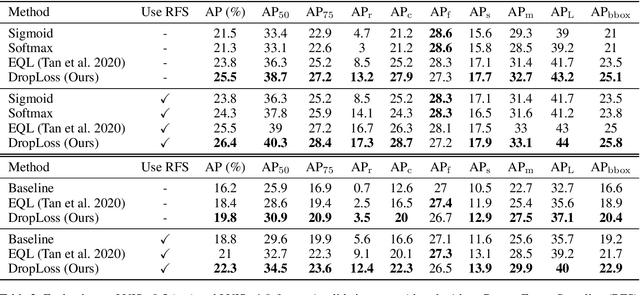Esther Robb
DropLoss for Long-Tail Instance Segmentation
Apr 17, 2021



Abstract:Long-tailed class distributions are prevalent among the practical applications of object detection and instance segmentation. Prior work in long-tail instance segmentation addresses the imbalance of losses between rare and frequent categories by reducing the penalty for a model incorrectly predicting a rare class label. We demonstrate that the rare categories are heavily suppressed by correct background predictions, which reduces the probability for all foreground categories with equal weight. Due to the relative infrequency of rare categories, this leads to an imbalance that biases towards predicting more frequent categories. Based on this insight, we develop DropLoss -- a novel adaptive loss to compensate for this imbalance without a trade-off between rare and frequent categories. With this loss, we show state-of-the-art mAP across rare, common, and frequent categories on the LVIS dataset.
* Code at https://github.com/timy90022/DropLoss
Few-Shot Adaptation of Generative Adversarial Networks
Oct 22, 2020



Abstract:Generative Adversarial Networks (GANs) have shown remarkable performance in image synthesis tasks, but typically require a large number of training samples to achieve high-quality synthesis. This paper proposes a simple and effective method, Few-Shot GAN (FSGAN), for adapting GANs in few-shot settings (less than 100 images). FSGAN repurposes component analysis techniques and learns to adapt the singular values of the pre-trained weights while freezing the corresponding singular vectors. This provides a highly expressive parameter space for adaptation while constraining changes to the pretrained weights. We validate our method in a challenging few-shot setting of 5-100 images in the target domain. We show that our method has significant visual quality gains compared with existing GAN adaptation methods. We report qualitative and quantitative results showing the effectiveness of our method. We additionally highlight a problem for few-shot synthesis in the standard quantitative metric used by data-efficient image synthesis works. Code and additional results are available at http://e-271.github.io/few-shot-gan.
NAS-DIP: Learning Deep Image Prior with Neural Architecture Search
Aug 26, 2020



Abstract:Recent work has shown that the structure of deep convolutional neural networks can be used as a structured image prior for solving various inverse image restoration tasks. Instead of using hand-designed architectures, we propose to search for neural architectures that capture stronger image priors. Building upon a generic U-Net architecture, our core contribution lies in designing new search spaces for (1) an upsampling cell and (2) a pattern of cross-scale residual connections. We search for an improved network by leveraging an existing neural architecture search algorithm (using reinforcement learning with a recurrent neural network controller). We validate the effectiveness of our method via a wide variety of applications, including image restoration, dehazing, image-to-image translation, and matrix factorization. Extensive experimental results show that our algorithm performs favorably against state-of-the-art learning-free approaches and reaches competitive performance with existing learning-based methods in some cases.
 Add to Chrome
Add to Chrome Add to Firefox
Add to Firefox Add to Edge
Add to Edge